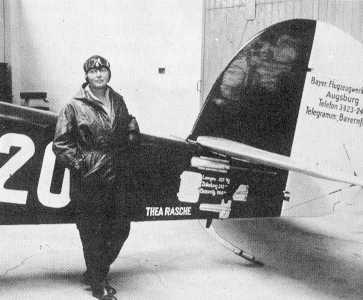Fraulein Rasche’s two Flamingos
One of the people that learned to fly with Paul Bäumer at the end of 1924 was the headstrong Fraulein Thea Rasche, the daughter
of a wealthy brewery owner from Essen. When Bäumer bought his first Udet Flamingo in 1925, Fraulein Rasche trained on it to
become Germany’s first woman aerobatics pilot.
From 1926 onwards, she participated in several flying meets, sometimes with other pilots of Bäumer-Aero. One day at an air display
in Hamburg, Bäumer wanted to spin the Flamingo with two aboard and included her in the invitation. The "stunt" developed into a flat
spin which Bäumer was unable to correct. Finally he raised both hands as if to say goodbye to Thea but, miraculously, the aircraft
then righted itself. . . a few feet above the ground. The smaller rudder of the early model, Udet built Flamingos, had nearly exacted
a fatal toll.
Early in 1927, and with only half-an-hour to go to the wedding ceremony, the lady rejected her fiance. As a consolation, her indulgent father handed over an impressive 50.000 Marks so that she could follow a career in aviation. Before long, Frau lein Rasche was at Augsburg taking delivery of a brand-new BFW Flamingo (D-1120; all-red fuselage like Udet’s D-822!) and being briefed by Willy Stör
Her role as a potential "Kunstfliegerin" or female "stunt pilot" was advanced when, in June 1927, she was told of the many opportunities awaiting her in the USA. The gentleman who proposed to be her manager (and was, typically, rejected) was none other than Charles A. Levine who had accompanied Clarence D. Chamberlin in a Bellanca W.B.2 called Miss Columbia (USAregistered NX-237) on a record non-stop flight from New York to a mere 100 miles short of Berlin (landing near Eisleben), June 4-6, 1927. This was only two weeks after Charles A. Lindbergh’s epic flight to Paris.
Thea Rasche seemed to "collecting" Atlantic fliers because, on route to London from Berlin by way of Essen, in Paris she met the newlyarrived Commander (later Admiral) Richard E. Byrd, USN, of Polar fame. His flight to Paris from New York, June 29-July 1,1927 (in the tri-motor Atlantic/Fokker C-2 America) had ended with a frustrating shoreline "ditching" at Ver-sur-Mer, n.w. of Caen.
From Paris to London, Flamingo D-1120 encountered very bad weather conditions. Shortly afterwards, Miss Rasche flew south again, this time to Southampton, where she enlisted the help of the inventor of the Autogiro, Spain’s Juan de Ia Cierva, in getting her U-12 aboard the liner Leviathan. It was during this transatlantic crossing that she heard of the tragic death of Bäumer on July 15, 1927. On arrival in the USA, Thea Rasche learned that she was not allowed to earn any money as she held a tourist-only visa. All she could do was to take part in contests in Providence and Worcester. Whereas in Germany she had earned the nickname "Die rasche Thea"-Fast Thea-in America she was soon known as "Rash Thea". While flying back to New York to attend her birthday party on August 12,1927, she could not resist the temptation to fly under the bridge at Albany. Judiciously it might seem, right at that moment the U-12’s engine "quit" (a fuel problem, not mechanical failure) and she was forced to land in the Hudson river. She refused a subsequent offer of $6,000.00 for the Flamingo’s recovered remains and simply had the aircraft burned. As it had been fully insured she was soon in receipt of a new Flamingo; Siemens & Halske even sent three mechanics with a brand-new engine. The new aircraft, D-1229 (c/n 334) was flown in America without any registration marks. (A project to fly the Atlantic with a Bellanca came to nothing and she returned to Germany.)
Thea Rasche did not like her new Flamingo (which she unkindly dubbed "Nebelkuh"- literally "Foggy Cow"!) and she sold it in 1928 to the DVS-Berlin for 16.000 Marks. The aircraft was re-engined in 1929 to become a U-12b and, during July and August of the same year, Dr. Pasewald and Dipl.lng. von Berg used D-1229 to make the longest voyage ever made with a Flamingo. They left on July 1 for a demonstration tour on behalf of Siemens & Halske AG. The Flamingo D-1229 (with an Sh 12 engine and 10 0/0 increased gross weight of 940 kg) was demonstrated at Vienna-Aspern, Graz-Thalerhof, Budapest, Belgrade, Bucharest, Gorno, Sofia, Thessaloniki, Athens, Brindisi, Naples, Rome, Pisa, Milan, St. Raphael, Marseilles and Barcelona; some 7.000 km (4,350 miles) flown in 60 hours during a period of six weeks. In November 1930, D-1229 went to the DVL and then in March 1932 to the DVS in Braunschweig (Brunswick). Finally, in April 1934, it went to the DLV as D-EKIP.
Fraulein Rasche was not the only aviatrix who flew the Flamingos regularly; others included Christelmarie Schultes, Lola Schröter and Nelly Tussmars. Like Lola, Nelly also made parachute jumps from Flamingos at air shows; and, on one occasion, she deliberately jumped into Lake Constance. Fraulein Tussmar’s 71st jump, at Chur in Switzerland, on June 16, 1929, ended fatally.

